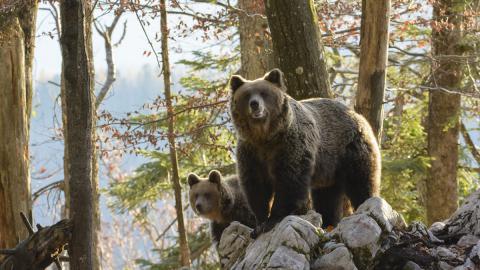
The EU recognises the importance of large carnivores like bears to our ecosystems. The EU Habitats Directive has been successful in protecting the brown bear. The EU Platform on Coexistence between People and Large Carnivores wants to minimise and find solutions to conflicts between humans and large carnivores. And the EU Biodiversity Strategy to 2030 aims at halting and reversing the decline of all species including bears.
The LIFE DINALP BEAR team, meanwhile, has successfully helped to manage brown bear populations in the northern Dinarides and southeastern Alps, recently winning a LIFE Award for Nature in the process. We caught up with its coordinator Rok Černe who works at the Slovenia Forest Service to find out more.
How did LIFE DINALP BEAR improve human-bear coexistence?
Well, bear populations are on the rise in Slovenia and across Europe. So, it is important that the public accepts them. If they don’t, the bears would be shot or poisoned, and their numbers would drop. We carried out several measures to improve acceptance.
For example, when households don’t properly store their waste, bears can become frequent visitors. We designed and installed special bear-resistant compost containers and rubbish bins at key locations in the partner countries of Croatia and Slovenia to put the bears off making an appearance.
Damage to beehives, livestock and gardens is one of the big causes of human-bear conflicts. To help with prevention in Slovenia and Italy, we erected electric fences and other devices like netting to deter brown bears from causing any damage.
We also used guard dogs to protect farmers’ livestock.
All of these actions have resulted in a 43% reduction in sheep attacks.
Also, attitudes towards bears remain positive in Slovenia despite the country’s population growth. This is down to our targeted and effective communication campaign.
What about traffic collisions?
We monitored some bears with GPS devices so that we could understand where they would try to cross the roads and highways. Based on this information and where the collisions took place, we installed electric fencing. The number of bears being hit by cars was down by a quarter at the end of the project.
Tell us about the bear-friendly label
The label was designed to award local products and services that promote a better coexistence between bears and humans. An example is a local honey manufacturer that is using electric fences to protect its beehives from bears and has added the label to its produce.
And the bear’s habitat?
Another aspect of the project was connecting habitats and bear populations. LIFE has in fact been working on this issue for around 20 years. We explored improving the ecological connections between Croatia and Slovenia to Trentino in Italy so that the bear would be able to move more freely, breed with other bears, and thrive well into the future.
What are you most proud of?
Before our project, there were no bear-proof garbage or compost bins in Slovenia. Now, these bins are more widespread. Our work over the past five years made this happen.
With rising bear populations, conflicts with humans could have increased but they didn’t, thanks to the measures that we put in place.
I’m also really proud of the collaboration between all of our partners. We developed a transnational strategy for managing bears which was approved by all the countries of the Alpine arc as well as Slovenia, Croatia and Bosnia and Herzegovina.
How do you feel about winning the LIFE Award for Nature?
It’s a great feeling. To be recognised for your hard work and dedication over five years is fantastic.
What’s next?
At the moment, we are working on the LIFE LYNX project where we are trying to save the Dinaric – SE Alpine lynx population from extinction. We also plan on setting up an information centre on large carnivores for the public. We will continue to install bear-proof garbage and compost bins and help farmers with electric fences and livestock guard dogs.
Details
- Publication date
- 9 December 2020
- Author
- Executive Agency for Small and Medium-sized Enterprises
